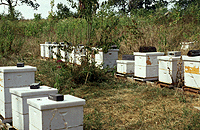Research Seeks to Control Mite Threat to Honey Bees
Research Seeks to Control Mite Threat to Honey Bees

In a laboratory at Kentucky State University researchers are seeking ways to control a tiny pest that's causing huge problems. The pest is a parasite called the Varroa mite, and since 1987 it's been slowly destroying honey bees across the United States, including Kentucky.
According to KSU bee Researcher and Extension specialist Tom Webster, the Varroa mite has reduced bee populations, and represents the worst problem beekeepers have ever faced.
"We have fewer hives kept by beekeepers, and definitely fewer wild bees living off on their own," said Webster. "Of course, most fruit crops and many vegetable crops require bee pollination, so many farmers now have to make special arrangements such as renting hives or owning their own."
A chemical treatment called fluvalinate has been used effectively against the mites since 1991, but some mites are now showing resistance. Recently the U.S. Environmental Protection Agency granted authority to Kentucky beekeepers to use a second chemical called coumaphos. Chemical treatments can work well for several years, but Webster sees a need to continue pursuing other kinds of control.
"Ultimately we're going to see a situation where mites become resistant to new chemicals," said Webster. "It's just a matter of time." Webster and his assistants are collecting bees, counting mites, and exploring different kinds of non-chemical control methods.
"One method we're working on is a simple trap device," he said. "We discovered that mites fall naturally from the bees down to the bottom of the hive. For very little cost, we can construct a trap with a screen that allows the mites to fall through, but prevents them from crawling back up to the bees."
Webster said he's also investigating honey bees that seem to have a natural resistance to the Varroa mite. He's working with the state's beekeepers to locate so-called "survivor hives."
"We've started something called the Survivor Hive Project with the help of Kentucky beekeepers," Webster said. "So far we've located over 40 survivor hives, and we're examining them here at KSU to see if they really have resistance to mites. We're seeing some real progress in this respect."
Webster said some of the bees appear to be, literally, "fighting back" against the mites.
"By examining dead mites to see if they are mangled or damaged, we can determine whether or not the bees are contributing to the deaths of those mites," he said.
After resistant strains are found, Webster said the next step is to breed the best stocks together to try and get more and more resistance over time. The last step would be to evaluate the resistant bees for other traits such as honey production, general temperament, ability to make it through the winter, and so on.